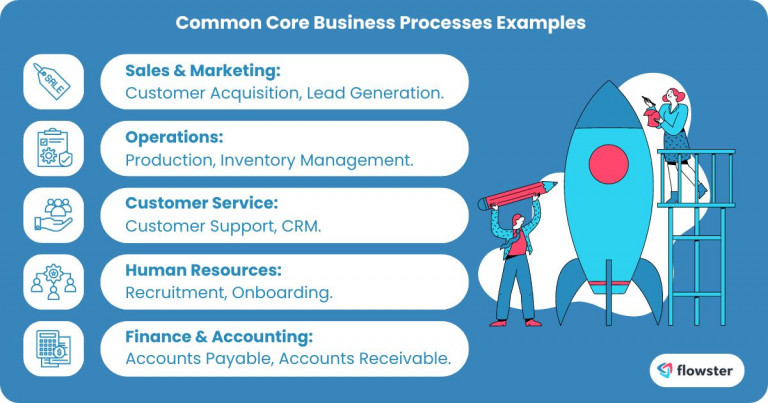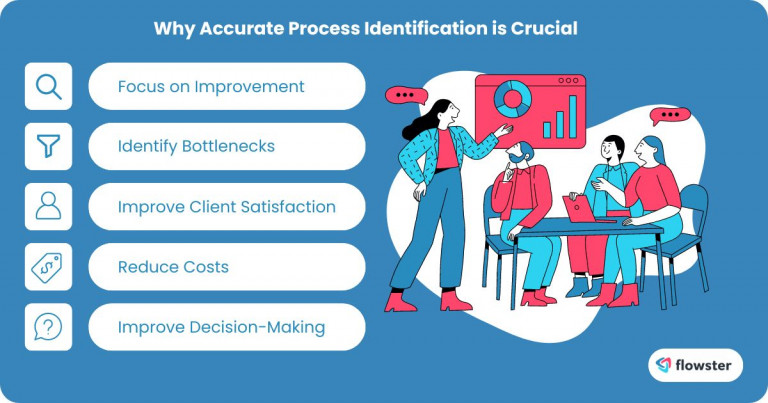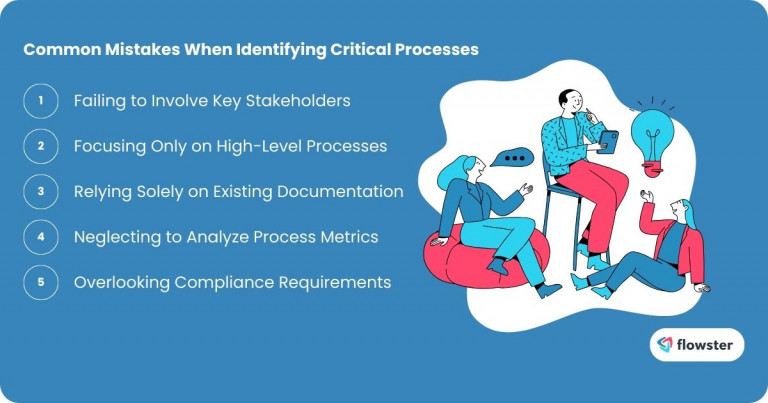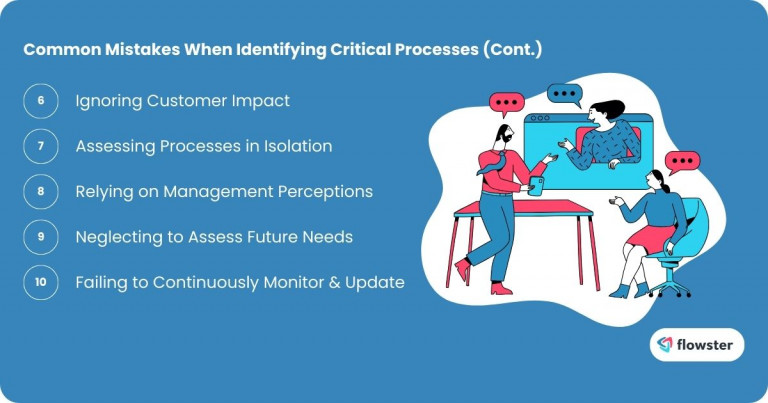Are you a small business owner, solopreneur, or freelancer struggling to keep up with the demands of your business? The key to unlocking your business’s full potential lies in identifying critical processes. These are the backbone of your operations, driving efficiency, quality, and ultimately, your bottom line.
Accurate process identification is a cornerstone of successful business improvement. By pinpointing the processes that truly matter, you can focus your time and resources on optimizing them for maximum impact. This can lead to increased efficiency, reduced costs, and improved customer satisfaction.
However, many small businesses and solopreneurs make common mistakes when trying to identify their critical processes. In this post, we’ll delve into these pitfalls and provide practical guidance to help you accurately identify and prioritize your business’s most important processes.
Article Outline
Understanding Critical Processes
Before diving into common pitfalls, let’s clarify what we mean by critical processes and why they matter.
What is a Critical Business Process?
A critical business process is a sequence of activities that significantly impacts your business’s performance, customer satisfaction, or overall success. These processes are the lifeblood of your operation and directly contribute to your bottom line. Whether you’re a solopreneur managing client projects or a small business handling sales and operations, identifying these critical processes is essential.
Common Critical Processes in Most Businesses
While the specific critical processes will vary depending on the industry, size, and nature of a business, there are several core functions that are often considered critical:
- Sales and Marketing: This includes lead generation, customer acquisition, sales pipeline management, and marketing campaigns.
- Customer Service: Handling customer inquiries, resolving issues, and managing customer relationships are crucial for customer satisfaction and retention.
- Operations: This encompasses production, inventory management, supply chain management, and order fulfillment.
- Finance and Accounting: Financial planning, budgeting, invoicing, payroll, and financial reporting are essential for business stability.
- Human Resources: Recruiting, hiring, onboarding, employee development, and performance management are vital for building a strong workforce.
- IT and Technology: Managing IT infrastructure, software applications, data security, and network systems are crucial for business operations.
It’s important to note that these are just general examples, and the specific critical processes for your business may differ. A comprehensive analysis of your operations is necessary to accurately identify the processes that have the greatest impact on your success.

Why Accurate Process Identification is Crucial
Pinpointing your critical processes is the first step towards effective business improvement. By focusing your efforts on these core areas, you can maximize your return on investment (ROI) for process optimization. Accurate process identification allows you to:
- Prioritize improvement initiatives: Allocate resources wisely to processes that have the greatest impact.
- Identify bottlenecks: Uncover areas where your business is hindered by inefficient processes.
- Enhance customer experience: Directly address processes that affect customer satisfaction.
- Reduce costs: Streamline operations and eliminate waste in critical areas.
- Improve decision-making: Make data-driven choices based on process performance metrics.
Consequences of Misidentifying Critical Processes
Failing to accurately identify your critical processes can have serious consequences. You might waste valuable time and resources on non-critical activities, overlook opportunities for improvement, and ultimately hinder your business’s growth. Additionally, misidentification can lead to decreased efficiency, lower customer satisfaction, and missed revenue opportunities.
Understanding the importance of critical processes is crucial for laying the groundwork for effective process improvement. In the next section, we’ll explore common mistakes businesses make when trying to identify these vital components of their operations.

Common Mistakes When Identifying Critical Processes to Avoid
Identifying critical business processes is essential, but many businesses make common errors that hinder their efforts. Let’s explore these pitfalls and how to avoid them.
Mistake 1: Failing to Involve Key Stakeholders
Successful process identification requires a collaborative approach. Neglecting to involve employees, managers, and other stakeholders who directly interact with the processes can lead to a distorted view of criticality.
To effectively involve stakeholders, consider conducting interviews, focus groups, or surveys. Encourage open communication and value their insights.
Mistake 2: Focusing Only on High-Level Processes
While high-level processes provide a broad overview, a deeper understanding is crucial. Concentrating solely on top-level processes can mask critical details and interdependencies within subprocesses.
Break down high-level processes into smaller, more manageable components. This granular view will help you uncover hidden inefficiencies and identify true criticalities.
Mistake 3: Relying Solely on Existing Documentation
Process maps, SOPs, and other documentation are valuable resources, but they often don’t capture the full picture. Relying solely on these documents can lead to overlooking undocumented workarounds and informal practices that are essential to the process.
Observe how work is actually done by shadowing employees and conducting process walkthroughs. This first-hand knowledge will provide a more accurate understanding of the process.
Mistake 4: Neglecting to Analyze Process Metrics
Data-driven decision-making is essential for identifying critical processes. Ignoring process metrics like cycle times, error rates, and customer satisfaction can lead to inaccurate assessments.
Gather and analyze relevant data to identify processes with the greatest impact on key performance indicators (KPIs). This data-driven approach will help you prioritize improvement efforts.
Mistake 5: Overlooking Regulatory and Compliance Requirements
Compliance-related processes are often critical but easily overlooked. Failure to identify these processes can expose your business to significant risks, including fines and legal issues.
Conduct a thorough assessment of your industry’s regulations and internal compliance standards. Identify processes that are essential for meeting these requirements.

Mistake 6: Ignoring Customer Impact
A customer-centric approach is essential for identifying critical processes. Neglecting to consider how processes impact the customer experience can lead to missed opportunities for improvement and decreased customer satisfaction.
Map out the customer journey and identify touchpoints where your business interacts with customers. Evaluate how processes contribute to or hinder a positive customer experience.
Mistake 7: Assessing Processes in Isolation
Processes are interconnected and influence each other. Examining processes in isolation can lead to suboptimal prioritization and missed opportunities for improvement.
Create a process map to visualize how different processes relate to each other. Identify dependencies and potential bottlenecks that impact overall performance.
Mistake 8: Relying Too Heavily on Management Perceptions
While management input is valuable, relying solely on their perceptions can lead to biased assessments. Frontline employees often have a deeper understanding of process challenges and opportunities.
Combine top-down and bottom-up perspectives by gathering input from both management and employees. This balanced approach will provide a more accurate picture of process criticality.
Mistake 9: Neglecting to Assess Future Needs
Focusing solely on current processes can leave your business unprepared for future challenges and opportunities. Ignoring potential changes in the market, technology, or customer needs can hinder your ability to adapt.
Conduct a swot analysis to identify potential threats and opportunities. Consider how these factors might impact your critical processes, and adjust your strategy accordingly.
Mistake 10: Failing to Continuously Monitor and Update
Business processes are dynamic and evolve over time. Failing to regularly review and update your list of critical processes can lead to outdated information and missed opportunities for improvement.
Establish a process review cadence and assign responsibility for monitoring and updating process information. This ongoing effort ensures that your critical process list remains relevant.
By avoiding these common mistakes, you can develop a more accurate and comprehensive understanding of your critical business processes. This knowledge will empower you to make informed decisions and drive significant improvements in efficiency and performance.

Conclusion: Take Action on Your Critical Processes
Identifying your critical business processes is a crucial step towards driving efficiency, improving quality, and boosting your bottom line. By understanding what truly matters and avoiding common pitfalls, you can unlock your business’s full potential.
Remember, accurate process identification requires a collaborative approach, data-driven analysis, and a focus on customer impact. By involving key stakeholders, analyzing process metrics, and considering the entire value chain, you’ll be well-equipped to pinpoint your critical processes.
Don’t wait to start your process improvement journey. Begin by taking stock of your current operations and identifying areas that could benefit from optimization.
Flowster's AI-Driven Automation
Document Critical Business Processes In Minutes
To help you get started, Flowster Marketplace offers a range of free process templates and other workflow templates to assist you in documenting your critical processes. If you need more comprehensive support, our “Done-for-You” services can provide expert guidance and implementation.
By taking action and leveraging the right tools and resources, you can transform your business through effective process management.
Let Flowster be your partner in documenting critical business processes and taking your business to the next level!




